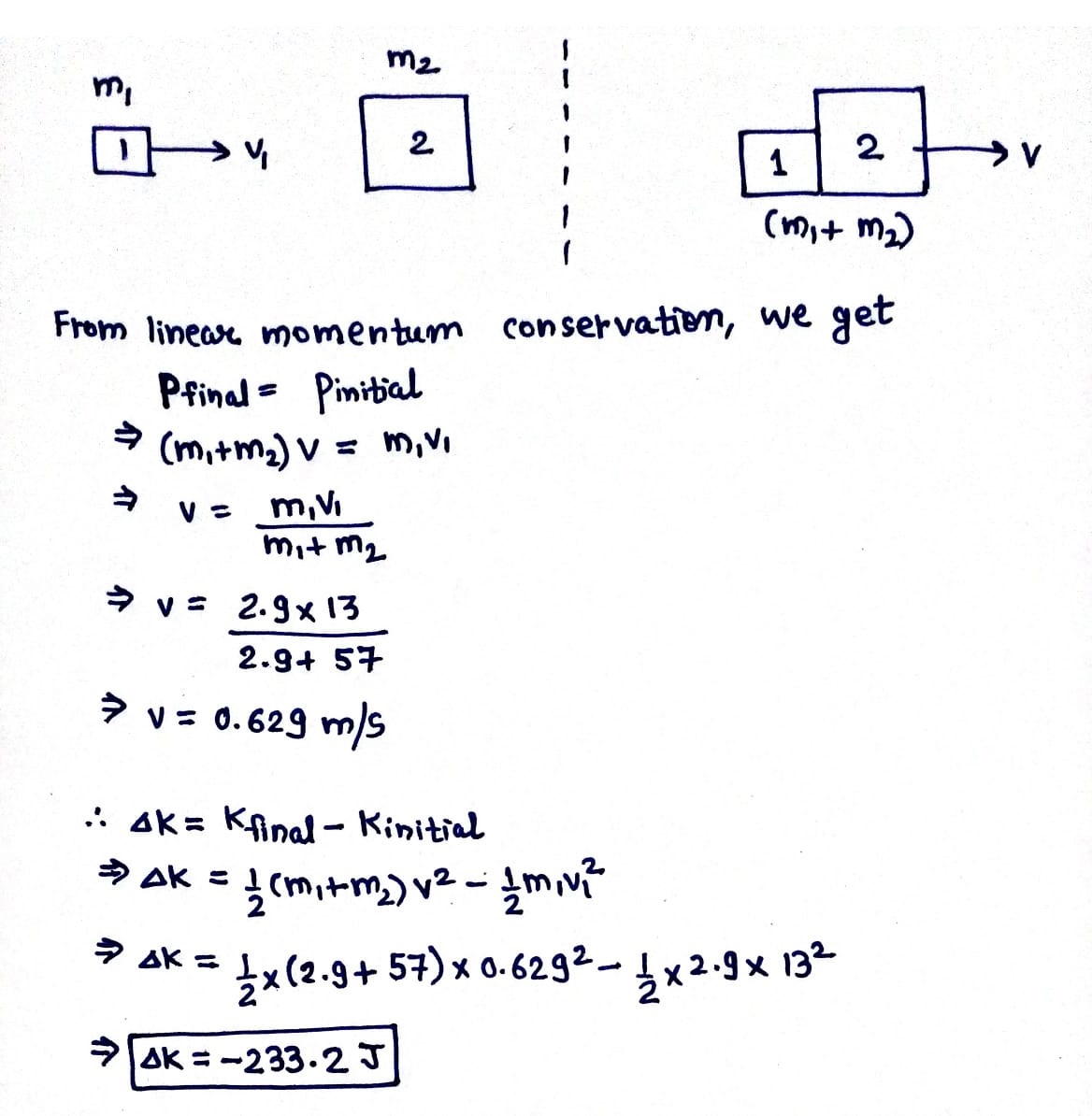Block 1, of mass mį = 2.90 kg , moves along a frictionless air track with speed v1 = 13.0 m/s. It collides with block 2, of mass m2 = 57.0 kg , which was initially at rest. The blocks stick together after the collision. (Figure 1) Part A Part B Part C What is the change AK = Kfinal – Kịnitial in the two-block system's kinetic energy due to the collision? Express your answer numerically in joules. • View Available Hint(s) Figure 1 of 1 ? Before collision: m2 m1 AK = J 2 Submit After collision: Provide Feedback 1
Block 1, of mass mį = 2.90 kg , moves along a frictionless air track with speed v1 = 13.0 m/s. It collides with block 2, of mass m2 = 57.0 kg , which was initially at rest. The blocks stick together after the collision. (Figure 1) Part A Part B Part C What is the change AK = Kfinal – Kịnitial in the two-block system's kinetic energy due to the collision? Express your answer numerically in joules. • View Available Hint(s) Figure 1 of 1 ? Before collision: m2 m1 AK = J 2 Submit After collision: Provide Feedback 1
College Physics
11th Edition
ISBN:9781305952300
Author:Raymond A. Serway, Chris Vuille
Publisher:Raymond A. Serway, Chris Vuille
Chapter1: Units, Trigonometry. And Vectors
Section: Chapter Questions
Problem 1CQ: Estimate the order of magnitude of the length, in meters, of each of the following; (a) a mouse, (b)...
Related questions
Question
![**Educational Content: Analyzing Collisions**
In this example, we examine a collision event involving two blocks on a frictionless air track. The collision is analyzed to determine the change in kinetic energy of the system.
### Problem Statement
- **Block 1**: Mass \( m_1 = 2.90 \, \text{kg} \), initially moving with speed \( v_1 = 13.0 \, \text{m/s} \).
- **Block 2**: Mass \( m_2 = 57.0 \, \text{kg} \), initially at rest.
The blocks collide and stick together, forming a single system after the collision.
### Diagram Explanation
- **Before Collision**:
- Block 1 is shown moving towards Block 2, which is stationary. The velocity of Block 1 (\( v_1 \)) is indicated by a green arrow pointing to the right.
- Block 1 is marked with \( m_1 \) and Block 2 with \( m_2 \).
- **After Collision**:
- Both blocks move together with a common velocity \( v_f \), indicated by a larger green arrow showing the direction of motion.
### Task
- Calculate the change in kinetic energy (\( \Delta K \)) of the two-block system due to the collision. This is given by the formula:
\[
\Delta K = K_{\text{final}} - K_{\text{initial}}
\]
- Express the answer in joules.
This exercise is crucial for understanding the principles of momentum conservation and energy transformation in collisions. Use the hints provided to guide your calculations, and input your response in the provided space.
**Note:** This educational tool promotes comprehension of physical concepts through interactive problem-solving and visual aids.](/v2/_next/image?url=https%3A%2F%2Fcontent.bartleby.com%2Fqna-images%2Fquestion%2F54a9d33b-c075-4af5-8013-3f49004b10ba%2Fe3e92b1a-9c57-4e3e-ac9f-8bd0eab2ccbc%2F86jca79_processed.png&w=3840&q=75)
Transcribed Image Text:**Educational Content: Analyzing Collisions**
In this example, we examine a collision event involving two blocks on a frictionless air track. The collision is analyzed to determine the change in kinetic energy of the system.
### Problem Statement
- **Block 1**: Mass \( m_1 = 2.90 \, \text{kg} \), initially moving with speed \( v_1 = 13.0 \, \text{m/s} \).
- **Block 2**: Mass \( m_2 = 57.0 \, \text{kg} \), initially at rest.
The blocks collide and stick together, forming a single system after the collision.
### Diagram Explanation
- **Before Collision**:
- Block 1 is shown moving towards Block 2, which is stationary. The velocity of Block 1 (\( v_1 \)) is indicated by a green arrow pointing to the right.
- Block 1 is marked with \( m_1 \) and Block 2 with \( m_2 \).
- **After Collision**:
- Both blocks move together with a common velocity \( v_f \), indicated by a larger green arrow showing the direction of motion.
### Task
- Calculate the change in kinetic energy (\( \Delta K \)) of the two-block system due to the collision. This is given by the formula:
\[
\Delta K = K_{\text{final}} - K_{\text{initial}}
\]
- Express the answer in joules.
This exercise is crucial for understanding the principles of momentum conservation and energy transformation in collisions. Use the hints provided to guide your calculations, and input your response in the provided space.
**Note:** This educational tool promotes comprehension of physical concepts through interactive problem-solving and visual aids.
Expert Solution
Solution :

Step by step
Solved in 2 steps with 1 images

Recommended textbooks for you

College Physics
Physics
ISBN:
9781305952300
Author:
Raymond A. Serway, Chris Vuille
Publisher:
Cengage Learning

University Physics (14th Edition)
Physics
ISBN:
9780133969290
Author:
Hugh D. Young, Roger A. Freedman
Publisher:
PEARSON

Introduction To Quantum Mechanics
Physics
ISBN:
9781107189638
Author:
Griffiths, David J., Schroeter, Darrell F.
Publisher:
Cambridge University Press

College Physics
Physics
ISBN:
9781305952300
Author:
Raymond A. Serway, Chris Vuille
Publisher:
Cengage Learning

University Physics (14th Edition)
Physics
ISBN:
9780133969290
Author:
Hugh D. Young, Roger A. Freedman
Publisher:
PEARSON

Introduction To Quantum Mechanics
Physics
ISBN:
9781107189638
Author:
Griffiths, David J., Schroeter, Darrell F.
Publisher:
Cambridge University Press

Physics for Scientists and Engineers
Physics
ISBN:
9781337553278
Author:
Raymond A. Serway, John W. Jewett
Publisher:
Cengage Learning

Lecture- Tutorials for Introductory Astronomy
Physics
ISBN:
9780321820464
Author:
Edward E. Prather, Tim P. Slater, Jeff P. Adams, Gina Brissenden
Publisher:
Addison-Wesley

College Physics: A Strategic Approach (4th Editio…
Physics
ISBN:
9780134609034
Author:
Randall D. Knight (Professor Emeritus), Brian Jones, Stuart Field
Publisher:
PEARSON